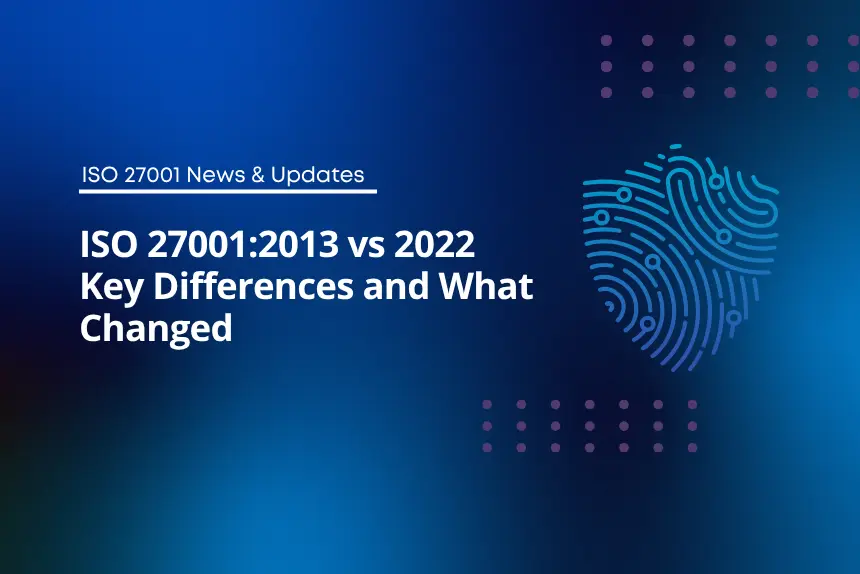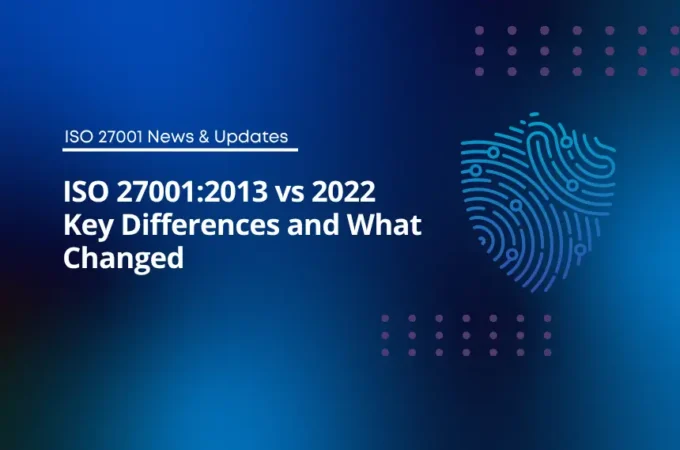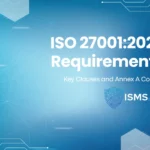Compare ISO 27001:2013 vs 2022. Learn about the most important changes, new controls, and requirements for making the switch to the new ISO 27001:2022 standard.
Table Of Content
- ISO 27001:2013 vs 2022 – Key Differences and What Changed
- Scope of the 2022 Revision
- Comparison of Structures
- Key Changes in ISO 27001:2022
- Alignment with ISO/IEC 27002:2022
- Introduction of 11 New Controls
- Consolidation and Renaming of Controls
- New Control Attributes
- Minor Updates to Management System Clauses
- Terminology and Formatting Changes
- Improved Integration with Cybersecurity and Privacy Standards
- Certification Transition Period
- Transition Timeline and Certification
- Impact on Existing ISMS
- Commentary
- Status
ISO 27001:2013 vs 2022 – Key Differences and What Changed
The ISO 27001:2022 update brings the world’s most important information security standard up to date. It fits with new technologies, changing threats, and the updated ISO/IEC 27002 framework from 2022.
Scope of the 2022 Revision
The 2022 edition has the same overall structure and purpose, but it uses more precise language, is more in line with risk management practices, and has an updated Annex A that is similar to ISO/IEC 27002:2022.
Comparison of Structures
- Core Clauses (4–10): Mostly the same, but with some clarifications and better consistency.
- Annex A Controls: A big change: the number of controls went from 114 in 2013 to 93 in 2022, and they were grouped into four main themes:
- Organizational Controls
- People Controls
- Physical Controls
- Technological Controls
Key Changes in ISO 27001:2022
The 2022 update to ISO 27001 makes specific but important changes that bring the standard up to date and make it more relevant to cybersecurity and risk management. The management system clauses (4–10) are mostly the same, but the revision focuses on making the language clearer, making it more in line with ISO 27002:2022, and making Annex A controls more useful in today’s digital world.

Alignment with ISO/IEC 27002:2022
The biggest change is that Annex A is now completely in line with ISO 27002:2022, which was completely rewritten. The control set has been reorganized, shortened, and updated to reflect the latest trends and technologies in information security.
- Number of controls reduced from 114 to 93.
- Controls are now organized into four key categories instead of 14 domains:
- Organizational (37 controls)
- People (8 controls)
- Physical (14 controls)
- Technological (34 controls)
- Many similar or overlapping controls from the 2013 version were merged for simplicity.
Introduction of 11 New Controls
The 2022 edition adds 11 entirely new controls that address emerging threats and digital practices:
- Threat Intelligence (5.7) – Focuses on gathering and using threat data to enhance risk decisions.
- Information Security for Cloud Services (5.23) – Ensures secure management and use of cloud environments.
- ICT Readiness for Business Continuity (5.30) – Integrates IT resilience with business continuity planning.
- Physical Security Monitoring (7.4) – Introduces proactive surveillance and response to physical threats.
- Configuration Management (8.9) – Ensures secure configurations of systems and devices.
- Information Deletion (8.10) – Covers safe, verified deletion of information across media types.
- Data Masking (8.11) – Protects sensitive data by obscuring identifiers in non-production environments.
- Data Leakage Prevention (8.12) – Focuses on detecting and preventing unauthorized data transmission.
- Monitoring Activities (8.16) – Emphasizes active monitoring and logging to detect anomalies.
- Web Filtering (8.23) – Introduces control for safe browsing and network filtering.
- Secure Coding (8.28) – Encourages best practices in software development security.
These additions highlight the growing emphasis on cyber resilience, data protection, and secure technology management.

Consolidation and Renaming of Controls
Several controls have been merged or renamed for clarity and consistency. For example:
- Access control topics were simplified into a more cohesive structure.
- Security policies and supplier relationships were streamlined.
- Technical terms were harmonized across ISO 27000-series standards.
New Control Attributes
Each Annex A control now includes five new “attributes” (introduced in ISO27002:2022), allowing organizations to classify and filter controls in flexible ways.
These attributes are:
- Control Type – Preventive, Detective, or Corrective
- Information Security Properties – Confidentiality, Integrity, Availability
- Cybersecurity Concepts – Identify, Protect, Detect, Respond, Recover
- Operational Capabilities – e.g., Governance, Physical Security, Identity Management
- Security Domains – People, Physical, Technological, Organizational
This change supports risk-based thinking and digital governance alignment, making control selection and mapping much more adaptable.
Minor Updates to Management System Clauses
The core ISMS structure (Clauses 4–10) remains familiar, but minor refinements have been made:
- Clause 6.2 (Information Security Objectives): Clarifies how objectives should be measured and monitored.
- Clause 6.3 (Change Management): Newly added, requiring planned management of ISMS changes.
- Clause 9.3 (Management Review): Updated inputs for management reviews, including opportunities for improvement.
These adjustments improve traceability, planning, and continuous improvement within the ISMS lifecycle.
Terminology and Formatting Changes
The 2022 version uses simpler, more consistent terminology, aligning ISO 27001 with other modern ISO Management System Standards (MSS). Examples:
- “Information security risk treatment plan” replaces “risk treatment process.”
- “Documented information” replaces separate references to “documents and records.”
- Gender-neutral and plain language adopted throughout.
Improved Integration with Cybersecurity and Privacy Standards
ISO/IEC 27001:2022 better connects with related frameworks, including:
- ISO/IEC 27002:2022 (controls guidance)
- ISO/IEC 27017 (cloud security)
- ISO/IEC 27018 (data privacy for cloud)
- ISO/IEC 27032 (cybersecurity management)
This integration supports organizations adopting holistic information security, cybersecurity, and privacy protection practices.
Certification Transition Period
Organizations certified under ISO/IEC 27001:2013 must transition to the 2022 version within three years of its publication (by 2025).
During this period:
- Certification bodies may audit to either standard.
- Transition audits will focus on updated Annex A controls and clause revisions.
Transition Timeline and Certification
Organizations certified to ISO/IEC 27001:2013 must transition to ISO/IEC 27001:2022 within the defined three-year migration period. Certification bodies will stop issuing 2013 certificates after the deadline.
Impact on Existing ISMS
Most management system processes (context, leadership, performance evaluation, improvement) remain valid. However, risk treatment plans and the Statement of Applicability must be updated to reflect the new Annex A control set.
Commentary
The 2022 revision reflects the shift toward digital transformation, cloud adoption, and cybersecurity resilience. While not a complete overhaul, it significantly improves clarity and alignment with modern practices.
Status
ISO 27001:2022 was officially published on October 25, 2022, replacing the 2013 edition. The new version is now the current valid standard for certification.
ISO and ISO/IEC 27001 are registered trademarks of the International Organization for Standardization (ISO). For official information, visit ISO’s official website





